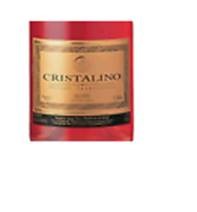In a recent decision from Mrs Justice Rose, the famous champagne house Roederer has successfully sued J Garcia Carrion SA (JGC) for trade mark infringement. JGC’s use of CRISTALINO in respect of cava infringed Roederer’s registered mark CRISTAL.
The outcome seems straightforward enough (though it is worth noting for completeness that the defendants were not represented at trial). The infringement comparison involves an assessment of whether there is likely to be confusion between the sign as used in context (shown below right) against the registered mark CRISTAL (and in this case, whether the use of CRISTALINO took unfair advantage of or was detrimental to the distinctive character or repute of CRISTAL).
The label hints at what JGC was getting at, and there were references in the evidence to Cristalino being seen “in effect as a poor man’s Cristal”.
What is perhaps the most interesting point from the perspective of an Australian trade mark lawyer is the impact of the evidence of reputation in the CRISTAL mark in assisting Roederer in making out its infringement case. The reputation was established via a number of means:
- there were many references in the media to CRISTAL champagne, including reviews, references to celebrities buying and drinking CRISTAL (including at Brad Pitt and Jennifer Aniston’s wedding);
- surveys conducted by an independent market research consultant as to the reputation of CRISTAL showed levels of recognition of CRISTAL in relation to champagne that Mrs Justice Rose accepted as showing “a strong reputation among a significant proportion of those who have previously bought champagne or sparkling wine”;
- CRISTAL had won a number of awards, including being given the maximum score in the champagne and sparkling wines category by Wine and Spirits Magazine in 2010;
- there were references to CRISTAL in popular song lyrics by JayZ and other rappers, which inferred that those rappers expected their fans to recognise the brand as a synonym for luxury. As an example, here is a memorable quote from wine critic Jancis Robinson:
“So here I am at the end of a very long working day/week/month, having poured myself (before others to come) a glass of the famous Cristal, for once from a fully mature vintage. It is also, incidentally, one of the very few wines that cuts the mustard with the under 23 year-olds in my household, thanks to various rappers’ espousal of the easiest-to-spot de luxe champagne of all.”
- there were instances of ordinary people making play on the similarity of the names CRISTAL and CRISTALINO, which also relied on the reader appreciating the significance of the CRISTAL mark (and was also considered as ‘free-riding’ in respect of reputation infringement).
Further, the reputation established was in CRISTAL alone (without reference to ‘Louis Roederer’ or ‘champagne’) and the nature of the reputation was that the CRISTAL brand is a top quality champagne of the very finest kind, is very expensive and therefore not available to everyone, and enjoyed by those with good taste.
With that in mind, Mrs Justice Rose assessed infringement as follows:
- Under article 9(1)(b) CTMR – there was a likelihood of direct confusion (ie. a consumer seeing the CRISTALINO product would mistake it for / think it was CRISTAL), and – of even greater weight in Mrs Justice Rose’s opinion – there was a likelihood of indirect confusion, which “occurs where the average customer believes that, because of the similarities of the mark and the sign and the similarity of the goods, the two brands might be linked in that one is an off shoot of the other and that they are both made by the same wine producer”. This was supported by evidence from Mr Bingley, “who described what is referred to in the trade as ‘second wine’ practice (known in French as “Second Vin”)”. In this case:
“Roederer are entirely justified in their concern that average consumers are likely to buy CRISTALINO cava thinking that it is a cheaper sparkling wine put on the market by Roederer to capitalise on the brand value of the CRISTAL name, just as Chandon is a cheaper sparkling wine from the Moët & Chandon house and Le Petit Mouton-Rothschild is a cheaper claret from Château Mouton-Rothschild”
- Under Article 9(1)(c) CTMR – there was ‘reputation infringement’ (ie. the use of the CRISTALINO sign took “unfair advantage of and is detrimental to the distinctive character and repute of the CRISTAL mark”). One aspect of this finding related to free-riding by JGC. There was evidence of images of people on social media with bottles of Cristalino, pretending in jest that they were bottles of Cristal, or making fun of the connection between the two names – it appears that some people had bought Cristalino rather than any other brand of cava so that they could make this joke.
That is, in EU trade mark infringement matters, the reputation of the earlier mark can assist in demonstrating a likelihood of confusion and the unfair advantage ground (reputation being a pre-requisite for the latter ground).
Commentary – a divergence?
The decision of Mrs Justice Rose will be seen as a positive one for brand owners, including in its acceptance of reputation based on a number of common sense factors.
As regards the press articles, it brings to mind the decision of Appointed Person Arnold QC (as he then was) in Case O-317-04, Lorna Morgan. In that case, in overturning the first instance decision, Mr Arnold QC held that the Hearing Officer clearly erred in giving little or no weight to press cuttings that were editorial in nature:
“First, editorial references to a trade mark are just as capable of boosting its reputation as paid-for advertising. Indeed, I believe that many consumers would regard an editorial mention as more of an incentive to purchase the goods in question than a paid-for advertisement. Secondly, editorial references are capable of shedding light on a trade mark’s existing reputation as well as enhancing that reputation.”
The findings as to practices in the field, eg. second wines, are also welcomed. These practices of course occur in other markets also, including notably the fashion market where secondary lines have been the norm for decades. The practice of regularly introducing new variations and co-branding in the confectionary market is another example (Chilli Choc Fling Tim Tam or Cadbury’s Dairy Milk Vegemite chocolate [you read that correctly], anyone?).
Given that a number of aspects of the Australian and EU infringement tests are the same, and given also that the basis of trade mark protection in each jurisdiction is the same – to protect the essential function of a trade mark, which is to distinguish the goods and services of one trader from those of other traders – it is notable from a comparative perspective that the cases in Australia have given inconsistent treatment to the relevance of reputation in assessing the likelihood of confusion. For example, Australian law has at times adopted the view that a greater reputation in the earlier mark can reduce the likelihood of confusion. A recent example of this in the opposition context is the decision in Delfi Chocolate Manufacturing SA v Mars Australia Pty Ltd [2015] FCA 1065 (1 October 2015), reported here, in which an opposition against MALTITOS based on the earlier mark MALTESERS was rejected by the Federal Court (overturning the initial decision to uphold the opposition). In finding that there was no likelihood of confusion, Jessup J took the view that Mars’ “very widespread, solid, reputation in the area of packaged confectionery” in fact decreased the likelihood of confusion posed by the use of the MALTITOS mark, finding that the relevant consumers “would be immediately struck by the differences between the two marks”.
This apparent divergence is particularly notable in light of the recent announcement that the Productivity Commission is to undertake an inquiry into Australia’s intellectual property arrangements, including by having regard to “the IP arrangements of Australia’s top intellectual property trading partners and the experiences of these and other advanced economies in reforming their IP systems to ensure those systems meet the needs of the modern economy”.
A discussion of the decision from our London colleagues can be seen here. The decisions are available on bailii.org and austlii.edu.au.









